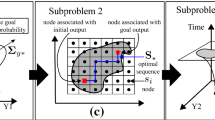Abstract
For a given continuous path, the problem of designing a time-optimal time-parametrization is considered. First, algorithms are presented which, under rather mild assumptions, yield the exact solution within two computational steps consisting of a forward and a backward computation. Then, the problem of quasi-continuous robot motion is investigated in detail. An algorithm of the same type results, but the computational burden is considerably reduced by making appropriate use of the special structure of the problem. By this, on-line use becomes feasible.
Similar content being viewed by others
Explore related subjects
Discover the latest articles, news and stories from top researchers in related subjects.References
AthansM. and FalbP.L., Optimal Control, McGraw-Hill, New York, (1966).
BobrowJ.E., DubowskyS., and GibsonJ.S., Time-Optimal Control of Robotic Manipulators Along Specified Paths. Int. J. Rob. Res. 4, 3–17 (1985).
BruhnH. and ErsüE., Grundlagen der analytischen Bewegungsplanung für Roboter, VDI Ber. 598, 461–472 (1986).
BrysonA.E. and HoY.-C., Applied Optimal Control, Hemisphere Publ. Corp., New York, revised printing (1975).
ChandS. and DotyK.L., On-line polynomial trajectories for robot manipulators, Int. J. Rob. Res. 4, 38–48 (1985).
DesoyerK., KopacekP., and TrochI., Industrieroboter und Handhabungsgeräte. Oldenbourg, Munich (1985).
GoldenbergA.A. and LawrenceD.L., End effector path generation, Trans. ASME, J. Dyn. Syst. Meas. Control 108, 158–162 (1986).
Goldenberg, A.A. and Benhabib, B., End effector optimal path generation, IEEE Trans. Syst. Meas. Control, submitted.
JeonH.T. and EslamiM., A minimum-time joint-trajectory planning for industrial manipulator with input torque constraints, 1986 IEEE Conf. Rob. Autom. 1, 559–564 (1986).
KimB.K. and ShinK.G., Minimum-time path planning for robot arms and their dynamics, IEEE Trans. Syst. Meas. Control 15, 213–223 (1985).
KnoblochH.W. and KappelF., Gewoehnliche Differentialgleichungen, Teubner, Stuttgart (1974).
Lee, C.S. and Lee, B.H., Planning of straight line manipulator trajectory in Cartesian space with torque constraints, Proc. 23rd CDC, 1603–1609 (1984).
LuhJ.Y.S. and LinC.S., Optimum path planning for mechanical manipulators. Trans. ASME, J. Dyn. Syst. Meas. Control 102, 142–151 (1981).
Luh, J.Y.S. and Walker, M.W., Minimum-time along the path for a mechanical arm, Proc. 16th CDC, 755–759 (1977).
PaulR., Manipulator Cartesian path control, IEEE Trans. Syst. Meas. Control 9, 702–711 (1979).
PaulR., Robot Manipulators, MIT Press, Cambridge, MA (1977).
Pesch, H.J., Real-time computation of feedback controls for constrained optimal control problems, 1, 2, Rpt. No. 12 (1987) and No. 14 (1987) des Schwerpunktprogrammes der DFG ‘Anwendungsbezogene Optimierung und Steuerung’, to appear in Optimal Control Appl. Methods.
PfeifferF., Optimierungsgesichtspunkte der Bahnplanung, Bahnsteuerung und-regelung. VDI Ber. 598, 415–430 (1986).
PfeifferF. and JohanniR., A concept for manipulator trajectory planning, IEEE J. Rob. Autom. 3, 115–123 (1987).
SchmittD., SoniA.H., SrinivasanV., and NaganathanG., Optimal motion planning of robot manipulators, J. Mechan. Transmiss. Autom. Design 107, 239–244 (1985).
Seeger, G.H. and Paul, R.P., Optimising robot motion along a predefined path, 1985 IEEE Conf. Rob. Autom., 765–770 (1985).
ShinK.G. and McKayN.D., Minimum-time control of robotic manipulators with geometric path constraints, IEEE Trans. Automatic Control 30, 531–541 (1985).
ShinK.G. and McKayN.D., A dynamic programming approach to trajectory planning of robotic manipulators, IEEE Trans. Automatic Control 31, 491–500 (1986).
ShinK.G. and McKayN.D., Minimum-time trajectory planning for industrial robots with general torque constraints, Proc. 1986 IEEE Conf. Rob. Autom. 1, 412–417 (1986).
SinghS. and LeuM.C., Optimal trajectory generation for robotic manipulators using dynamic programming, Trans. ASME, J. Dyn. Syst. Meas. Control 109, 88–96 (1987).
Troch, I., Time-optimal continuous path generation for industrial robots under realistic assumptions, to appear in Robotica.
Troch, I., Time-suboptimal quasi-continuous path generation for industrial robots, submitted.
VukobratovicM. and KircanskiK., A method for optimal synthesis of manipulation robot trajectories, Trans. ASME, J. Dyn. Syst. Meas. Control 104, 188–193 (1987).
Author information
Authors and Affiliations
Additional information
Work supported by Oesterreichischer Fonds zur Foerderung der wissenschaftlichen Forschung.
Rights and permissions
About this article
Cite this article
Troch, I. Time-optimal path generation for continuous and quasi-continuous path control of industrial robots. J Intell Robot Syst 2, 1–28 (1989). https://doi.org/10.1007/BF00450553
Received:
Issue Date:
DOI: https://doi.org/10.1007/BF00450553




